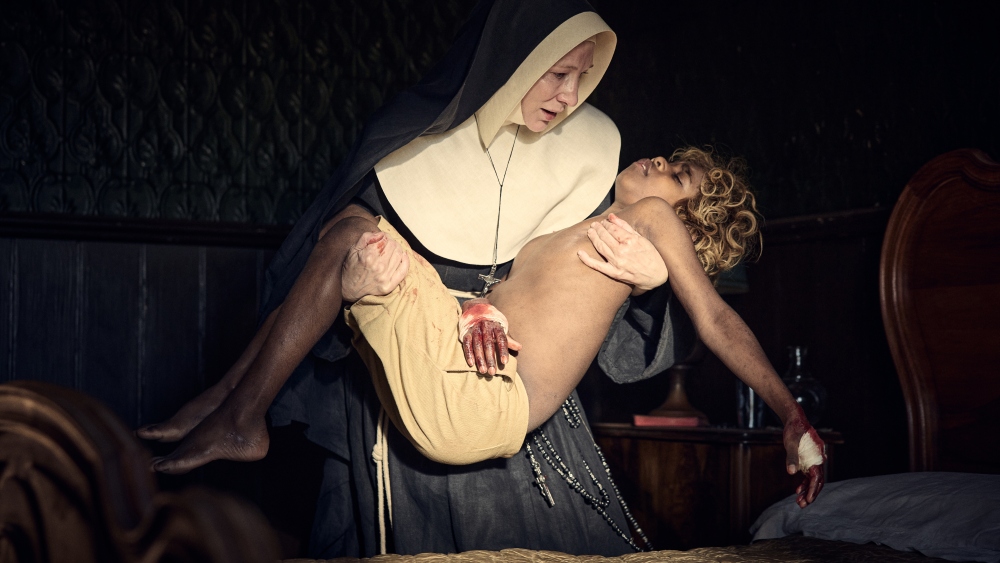‘The New Boy’ Review: Cate Blanchett in a Tale of Clashing Faiths
The new boy doesn’t get a name, and he doesn’t give one. Arriving at an isolated orphanage in rural South Australia in the early 1940s, he’s taken in with brisk kindness by the two nuns who oversee the place, but privileges like names are for children a little further along in their understanding and acceptance of this establishment’s firm Christian principles: Until he’s ready for baptism, the shirtless, mostly wordless Aboriginal newcomer will be acknowledged but not identified. It’s a limbo state that evocatively represents the tension between Australia’s Indigenous population and even the most notionally inclusive of their colonizers; in Warwick Thornton’s thoughtful magical-realist fable “The New Boy,” spiritual differences aren’t treated with violence, but echo bloody territorial conflict just the same.
Inspired by Thornton’s own experience of growing up as an Aboriginal boy in a Christian boarding school, this is ambitious, tonally tricky filmmaking, bringing an unexpected dose of whimsy to social interests more austerely explored in Thornton’s excellent previous features “Samson and Delilah” and “Sweet Country.” Meandering but never uninvolving, the film benefits, like its predecessors, from its writer-director-cinematographer’s extraordinary eye for light and locale, which goes beyond dewy pictorialism to reclaim a landscape from its imposing occupiers. The film’s visual splendor, along with a ripely entertaining performance by producer Cate Blanchett (in a rare return to Australian features) as the orphanage’s offbeat abbess, represent its chief selling points to international distributors; in the title role, kinetic, wide-eyed novice Aswan Reid is its secret weapon.
He is introduced to us as a frenzied whirl of movement in the propulsive, boldly stylized opening scene — heavy on slow-motion and the most reverberating excesses of Nick Cave and Warren Ellis’s typically expressive score — as the unnamed pre-teen lad is abducted by horseback police on a parched stretch of Outback desert, fighting his way free before being struck down by a returning boomerang. Tied in a hessian sack and driven far from home, he’s unceremoniously dumped on the doorstep of Sister Eileen (Blanchett), who runs a modest shelter for similarly abandoned boys — several of them Indigenous — in a remote monastery flanked by wheat fields and olive groves.
With war raging abroad and the monastery’s presiding monk having recently died, Sister Eileen does her best to avoid attracting the patriarchal interventions of the Church, with the assistance of two Aboriginal colleagues: fellow nun and matron figure Sister Mum (a wonderful Deborah Mailman) and burly farmhand George (Wayne Blair). That enables a more permissive environment than you might expect in such an institution — she doesn’t share the late monk’s taste for corporal punishment, for one thing — so the ungentrified behavior of the new arrival, who can’t speak English, eats with his hands and sleeps under his bed rather than on it, isn’t immediately disciplined.
But, dutiful nun that she is, Sister Eileen is big on religious conversion. And in this regard, the new boy — who may have uncanny spiritual powers of his own, as he sparks light from his fingertips and appears to heal wounds with his touch — presents more challenges than most. He’s not unreceptive to the concept of Jesus: When a large, ornately carved crucifix arrives at the chapel from France, for safekeeping during the Nazi invasion, he physically embraces the icon as eagerly as he does a tree in his natural habitat. But the good Sister, while well-meaning to a point, isn’t imaginative enough to see the parallels or commonalities between his belief system and hers, and can’t conceive of Indigenous spirituality and devout Christianity co-existing in one mind: The former must be quashed for the latter to take root, even at the expense of potential miracle-working.
The battle of wills and faiths that ensues is gradual and sometimes unspoken. Thornton is less interested in fire-and-brimstone showdowns than in a more quietly pervasive air of unease around the unfamiliar, with Sister Mum and George understanding more than they let on about the other world suddenly in their midst. Thornton sometimes underlines the historical and allegorical resonances of this strange duel with too heavy a hand, though there’s deft, witty symbolism here too: The new boy’s first baptism comes not with holy water but with stinging sheep dip for head lice, an animal treatment for an intruder not yet accepted into the human flock.
Nearly all grande dames of the screen must play a nun at some point in their careers, and Blanchett tackles this thespian rite with gusto, finding all manner of humanizing eccentricities in Sister Eileen’s assertive gait, quizzical gaze and pinched, tremulous preaching style. The star’s undimmed magnetism as a performer occasionally threatens to distract from the plainer ideological matters at hand — or it might if Reid weren’t her contrasting match in that department, as silent and penetratingly watchful as she is fretfully busy. With an intense, genuinely unworldly presence that never lapses into fey savant cliché, he asserts a point of view on his scenes that makes credible even some challenging swerves into fantastical terrain.
Thornton, for his part, balances the film’s more cluttered complexities with a confident visual serenity: As DP, his stark, immaculate compositions stress the dominant lines of the natural world — clean shafts of scorching sunlight, an infinite horizon — over the small, intricate architecture of human occupation, washing everything in earthy ochres and burnt khakis. Beneath orderly, undulating rows of wheat, there’s remains a memory of the untrammelled earth that still belongs the new boy and his people, of the unexplained powers that he draws from that land, even as they’re inched off it and into Western confinement.

